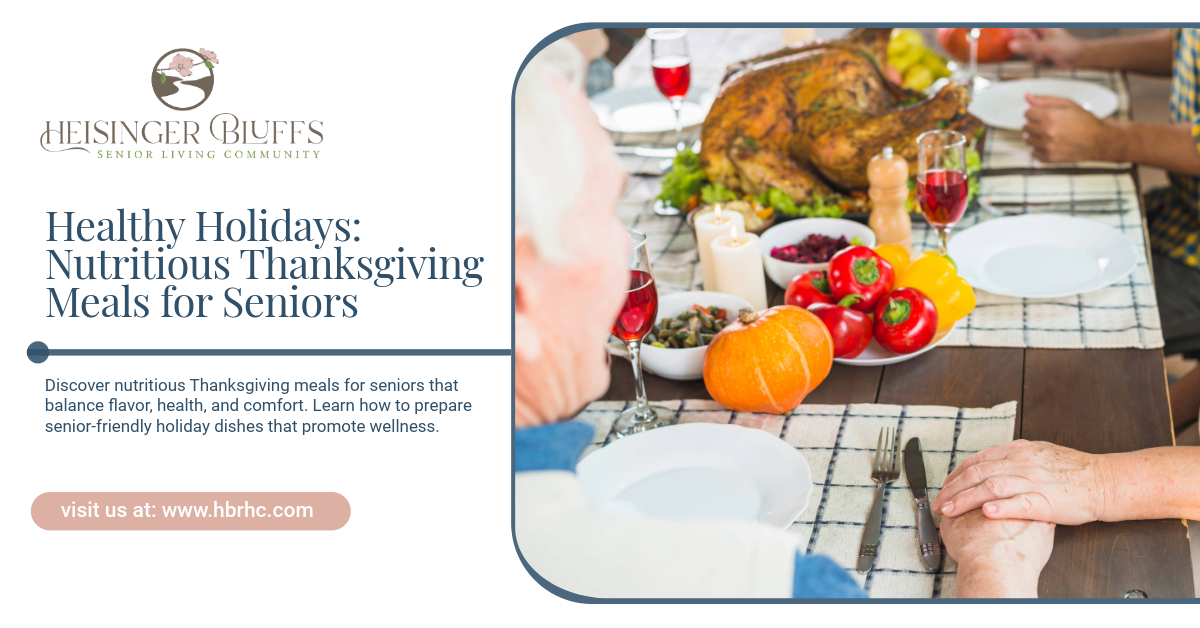Healthy Holidays: Nutritious Thanksgiving Meals for Seniors

Key Highlights
- Seniors can enjoy Thanksgiving with flavorful, nutrient-rich meals tailored to their dietary needs.
- Simple ingredient swaps make traditional dishes healthier and easier to digest.
- Balanced meals support energy, heart health, and digestion during the holidays.
- Portion control, hydration, and mindful eating help seniors avoid discomfort.
- Planning ensures a joyful and nourishing Thanksgiving for everyone.
Thanksgiving is a time to celebrate gratitude, family, and, of course, delicious food. But for seniors, traditional holiday feasts can sometimes bring challenges such as high sodium, sugar, or fat content. Whether due to dietary restrictions, digestion concerns, or chronic conditions like diabetes or heart disease, seniors benefit from meals that are both nourishing and enjoyable.
With a little planning and creativity, you can prepare nutritious Thanksgiving meals for seniors that maintain all the warmth and flavor of the season—without compromising health.
Let’s explore how to plan a balanced, delicious, and senior-friendly Thanksgiving menu.
Thanksgiving Meals for Seniors
1. Focus on Balanced Nutrition
A healthy Thanksgiving meal for seniors should include a balance of:
- Lean proteins for strength and muscle maintenance
- Fiber-rich foods to aid digestion
- Healthy fats for heart and brain health
- Fruits and vegetables for vitamins, minerals, and antioxidants
Try to keep meals colorful and varied. Each dish should contribute to overall nutrition while being easy to chew and digest.
2. Mindful Ingredient Swaps
Small ingredient adjustments can turn traditional recipes into healthier versions without losing flavor.
| Traditional Ingredient | Healthier Alternative | Benefits |
|---|---|---|
| Heavy cream or butter | Greek yogurt, olive oil, or mashed avocado | Reduces saturated fat |
| White flour | Whole wheat or almond flour | Adds fiber and nutrients |
| White potatoes | Sweet potatoes or cauliflower mash | Adds antioxidants and vitamin A |
| Sugar | Honey, stevia, or fruit puree | Lowers sugar intake |
| Salt | Herbs, lemon juice, or garlic | Enhances flavor naturally |
These swaps keep dishes lighter while ensuring seniors still enjoy their favorite Thanksgiving flavors.
3. Healthy Starters: Light and Flavorful
Appetizers set the tone for the meal—keep them light yet satisfying.
Healthy options include:
- Butternut squash soup: Creamy, naturally sweet, and packed with vitamins.
- Deviled eggs made with Greek yogurt: A protein-rich, heart-healthy twist.
- Fresh veggie platter with hummus: Easy to chew and rich in fiber and antioxidants.
- Fruit skewers: Add a splash of color and natural sweetness before the main meal.
Avoid heavy, fried, or overly salty appetizers that can reduce appetite for the main course.
4. Nutritious Main Courses
Turkey remains the star of Thanksgiving, but how it’s prepared matters.
- Choose lean cuts: White meat turkey without the skin provides high-quality protein and less fat.
- Bake or roast instead of frying: This reduces unnecessary oil and calories.
- Use fresh herbs and citrus: Rosemary, thyme, and lemon can flavor turkey beautifully without excess salt.
For seniors who prefer smaller portions or have difficulty chewing, shredded turkey breast mixed with light gravy can make eating easier and more enjoyable.
Alternative proteins like baked salmon, lentil loaf, or tofu can also provide a nutritious variety.
5. Healthy Sides That Steal the Show
Sides are often the most calorie-dense part of the meal. However, with smart tweaks, they can be both delicious and health-conscious.
Nutritious Side Dish Ideas:
- Cauliflower mash: Creamy, light, and easier to digest than traditional mashed potatoes.
- Roasted vegetables: Use carrots, Brussels sprouts, and squash tossed in olive oil and herbs.
- Whole-grain stuffing: Swap white bread for whole-grain bread and use low-sodium broth.
- Green bean almondine: Steam fresh beans and top with toasted almonds for crunch and protein.
- Sweet potato casserole: Skip the marshmallows—top with crushed nuts and a drizzle of maple syrup instead.
These sides provide vitamins, minerals, and fiber—supporting digestion and energy levels.
6. Smarter Sauces and Gravies
Traditional gravies and sauces often contain high amounts of sodium and fat. Instead:
- Use low-sodium broth and skim milk to make a lighter gravy.
- Replace butter with olive oil or a plant-based alternative.
- Thicken sauces with pureed vegetables like cauliflower or carrots instead of flour and cream.
These alternatives maintain rich flavor while promoting better heart and digestive health.
7. Desserts That Delight Without the Guilt
Seniors can absolutely enjoy dessert—with moderation and creativity.
Healthier Thanksgiving dessert options:
- Pumpkin pie with oat crust: Rich in vitamin A and fiber.
- Baked apples with cinnamon: Naturally sweet and comforting.
- Greek yogurt parfait: Layer with berries and a sprinkle of granola.
- Mini portions: Offer small servings to satisfy sweet cravings without overindulging.
Avoid overly sugary or heavy desserts that could cause blood sugar spikes or digestive discomfort.
8. Hydration Matters
Dehydration is common among seniors and can be overlooked during holiday meals. Encourage fluids throughout the day.
Good options include:
- Water infused with lemon, cucumber, or mint
- Herbal teas (like chamomile or peppermint)
- Low-sodium soups or broths
Avoid sugary drinks or those high in caffeine, which can lead to dehydration.
9. Portion Control and Mindful Eating
Large portions can overwhelm both the stomach and the appetite of older adults. Serve smaller, nutrient-dense plates to prevent overeating and discomfort.
Encourage mindful eating by:
- Eating slowly and savoring flavors
- Taking small bites and chewing thoroughly
- Pausing between bites to aid digestion
Thanksgiving is about connection and gratitude—not quantity—so slow, social meals are perfect for seniors.
10. Addressing Common Dietary Needs
Many seniors follow specific diets for health reasons. It’s important to tailor the meal accordingly.
| Condition | Tips for a Healthier Thanksgiving Meal |
|---|---|
| Diabetes | Choose complex carbs, avoid added sugars, and watch portion sizes. |
| Heart disease | Limit sodium and saturated fats; focus on omega-3-rich foods. |
| Digestive issues | Avoid spicy, fried, or high-fat foods; include fiber and hydration. |
| Dental problems | Offer soft foods like mashed vegetables, soups, or casseroles. |
| Low appetite | Add herbs and mild spices to enhance flavor and appeal. |
Understanding individual needs ensures everyone enjoys the meal safely and comfortably.
11. Encourage Social Connection
Eating together provides emotional nourishment as much as physical nourishment. For seniors, especially those living alone or in care settings, shared meals offer companionship and joy.
Encourage:
- Family-style serving to promote conversation and connection.
- Gentle background music for a warm atmosphere.
- Inclusive seating arrangements so seniors feel engaged.
Emotional well-being is just as vital to health as the meal itself.
12. Make Cooking a Shared Experience
Involve seniors in preparing Thanksgiving meals—they’ll appreciate the sense of purpose and connection.
Simple activities include:
- Stirring ingredients or arranging vegetables on trays
- Mixing salads or folding napkins
- Sharing family recipes or stories about past Thanksgivings
This fosters a sense of pride and nostalgia while creating meaningful moments together.
13. Plan for Leftovers Wisely
Thanksgiving leftovers are a tradition—but they can also be turned into balanced meals for days afterward.
Healthy leftover ideas:
- Turkey and vegetable soup
- Whole-grain sandwiches with lean turkey
- Sweet potato and spinach hash
- Turkey and quinoa salad
Store leftovers safely and reheat only what’s needed to maintain food quality.
A Thanksgiving Filled with Health and Gratitude
Thanksgiving doesn’t need to be indulgent to be joyful. With a little mindfulness, seniors can enjoy a flavorful feast that supports both health and happiness. From heart-healthy sides to easy-to-digest main courses, every bite can reflect care, comfort, and celebration.
At Heisinger Bluffs, we believe every meal should nourish both body and spirit. Our community offers personalized dining options designed for seniors’ unique nutritional needs, ensuring every resident enjoys safe, delicious, and wholesome meals—especially during the holidays. Whether through assisted living, memory care, or respite care, we make every celebration feel like home. Reach out today!
Frequently Asked Questions
What are the best Thanksgiving foods for seniors with difficulty chewing?
Soft foods like mashed vegetables, soups, casseroles, and tender turkey pieces are ideal. Avoid crunchy or tough textures that may be hard to chew.
How can I make Thanksgiving desserts healthier for seniors?
Use natural sweeteners like honey or fruit, swap heavy cream for yogurt, and focus on baked fruits or smaller portions of classic desserts.
What can seniors eat if they have heart disease or high blood pressure?
Opt for lean proteins, low-sodium dishes, whole grains, and healthy fats like olive oil or avocado. Avoid processed and salty foods.
How can I make traditional Thanksgiving recipes senior-friendly?
Reduce salt, sugar, and butter; use herbs for flavor; and substitute ingredients like Greek yogurt or olive oil to lighten recipes.
Why is hydration important during Thanksgiving?
Holiday meals often include salty or rich foods, which can increase dehydration risk. Encourage water, herbal teas, or broths to support digestion and energy.
Sources:











